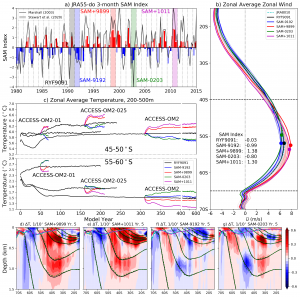The global ocean overturning circulation is the planetary-scale movement of waters in the vertical and north-south directions. It is the principal mechanism by which the oceans absorb, sink, and redistribute heat and carbon from the atmosphere, thereby regulating Earth’s climate. Despite its importance, it is impossible to observe directly, and must be inferred from sparse and infrequent proxy measurements. The main upward branches of the overturning circulation are located in the Southern Ocean, where strong westerly winds upwell waters from below. Thus, changes in these westerly winds will lead to changes in the overturning circulation, and, subsequently, Earth’s climate.
In a recently submitted paper, we introduce a new tool that we call the Ekman streamfunction to analyse the change of the winds in a framework that is directly comparable with the overturning circulation. We test the Ekman streamfunction with model output from ACCESS-OM2-01 in which the overturning circulation is measured directly. We find throughout much of the Southern Ocean, the Ekman streamfunction provides a robust indicator of the strength and variability of the overturning circulation, with exceptionally high correlation. Our new tool provides a novel approach for reexamining existing datasets of winds measured from satellites, to infer recent changes in the overturning circulation.
“The Ekman Streamfunction: a wind-derived metric to quantify the Southern Ocean overturning circulation”; Stewart, Hogg, England, Waugh & Kiss, Submitted to Geophysical Research Letters.
Unreviewed submission available here: https://www.essoar.org/doi/abs/10.1002/essoar.10506547.1
